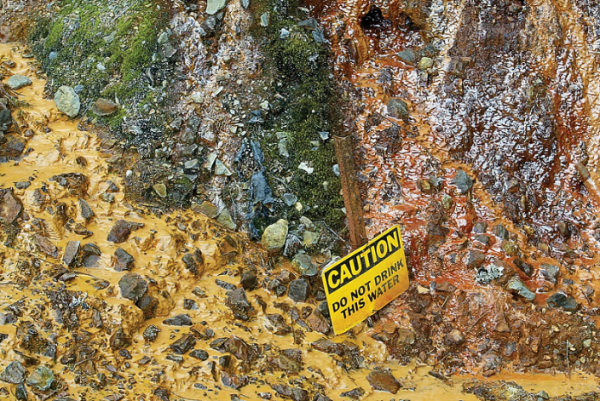Contact: Suzanne Skadowski, 206-553-2160, skadowski.suzanne@epa.gov
SEATTLE (Dec. 17, 2021) – Today, the U.S. Environmental Protection Agency announced that the Formosa Mine Superfund site near Riddle, Oregon, will receive Bipartisan Infrastructure Law funds to complete critical cleanup actions and protect human health and the environment. The Douglas County, Oregon, site is among 49 sites across the nation that will benefit from a $1 billion investment from the BIL to initiate cleanup and clear the backlog of previously unfunded Superfund sites and accelerate cleanup at other sites across the country. Until this historic investment, many of these were part of a backlog of hazardous waste sites awaiting funding. Thousands of contaminated sites exist nationally due to hazardous waste being dumped, left out in the open, or otherwise improperly managed. These sites include manufacturing facilities, processing plants, landfills, and mining sites.
“This work is just the beginning; with more than 1 in 4 Black and Hispanic Americans living within 3 miles of a Superfund site, EPA is working to serve people that have been left behind,” said EPA Administrator Michael S. Regan. “Approximately 60 percent of the sites to receive funding for new cleanup projects are in historically underserved communities. Communities living near many of the most serious uncontrolled or abandoned releases of contamination will finally get the protections they deserve.”
At the Formosa Mine site on Silver Butte, between Riddle and Canyonville, Oregon, discharges of acid rock drainage and toxic metals from the abandoned mine into the Middle Creek watershed, have contaminated surface water, groundwater, soils, and sediment with heavy metals, threatening fish and other aquatic species. EPA is now designing the first phase of cleanup to address all mine impacted material on the surface of the mine. Work will include excavating or capping areas contaminated with high metal concentrations and low pH (acidic) to stop contaminants from leaching through and flowing downstream during rain and snowmelt events. The second phase of cleanup will address risks to surface and groundwater at the site.
“Oregonians deserve clean water and a safe environment free of toxic chemicals,” Chair of the Senate Finance Committee Ron Wyden, D-Ore., said. “I am proud that the Infrastructure Package includes $21 billion to address legacy pollution, including cleaning up superfund sites like Formosa Mine near Riddle. It is long past time to get to work with cleanup efforts to reduce environmental and public health risks that contaminate our communities.”
“The bipartisan infrastructure law is already delivering in big ways, with dozens of new cleanup projects set to receive funding, including Formosa Mine in Riddle, Oregon,” said Congressman Peter DeFazio, D-Ore.-04. “Formosa has been leaching toxins for decades, discharging heavy metals that kill everything within 18 miles of the South Fork of Middle Creek, poisoning salmon habitat and drinking water. The funding announced today will better our environment, protect critical fish habitat, and undo the mess that has caused the most environmental damage due to mining in Oregon’s history.”
“This is great news from the EPA and will make a huge impact on the cleanup project at the Formosa Mine,” said Senator Jeff Merkley, D-Ore. “This abandoned zinc and copper mine has been poisoning the waters surrounding the site for years, and I’m glad it’s getting the crucial funding needed to address the pollution impacting the Middle Creek and South Fork Middle Creek watersheds. This funding will help make a difference in keeping our environment and communities safe and healthy.”
The $1 billion investment is the first wave of funding from the $3.5 billion in the Bipartisan Infrastructure Law to help cleanup polluted Superfund sites in communities. The backlog of previously unfunded sites that will now be receiving funding are in 24 states and territories and all 10 EPA regions, including some communities who have been waiting for cleanup for more than four years.
Along with new construction projects, infrastructure funds will be used to accelerate ongoing work and begin cleanup at additional Superfund sites in various stages of pre-construction and planning throughout the country. These cleanup projects will make a visible and lasting difference in communities.
The funds will supercharge the Superfund program to address the toll contaminated sites have on communities. EPA is finalizing cleanup plans and preparing funding mechanisms to get construction work started as soon as possible. More information about funding for backlogged sites and accelerated cleanup sites will be available in the coming weeks.
EPA is committed to carrying out this work in line with President Biden’s Justice40 Initiative by advancing environmental justice and incorporating equity considerations into all aspects of the Superfund cleanup process. This will help ensure that historic and ongoing impacts of contamination on overburdened communities are fully considered and addressed.
In 1980, the Comprehensive Environmental Response, Compensation and Liability Act, known as Superfund, was passed. The novel law gave EPA the authority and funds to hold polluters accountable for cleaning up the most contaminated sites across the country. When no viable responsible party is found or cannot afford the cleanup, funds appropriated by Congress are used. A tax on chemical and petroleum industries provided funds to the Superfund Trust fund for Superfund cleanups up until 1995. The Bipartisan Infrastructure Law reinstates the chemical excise taxes and invests an additional $3.5 billion in environmental remediation at Superfund sites, making it one of the largest investments in American history to address the legacy pollution that harms the public health of communities and neighborhoods. Find more information about EPA’s Superfund program at: https://www.epa.gov/superfund.
Photos show acidic water and runoff at the closed Formosa Mine between Riddle, Ore. and Canyonville, Ore. AP Photos/The News-Review, Andy Bronson (AP Photos. The News-Review, Andy Bronson)
EPA’s Region 10 serves communities in Alaska, Idaho, Oregon, Washington, and 271 Tribal Nations. Learn more about EPA’s work in the Pacific Northwest at: epa.gov/epa-region-10-pacific-northwest. Connect with us on Twitter: @EPAnorthwest and Facebook: @eparegion10.

